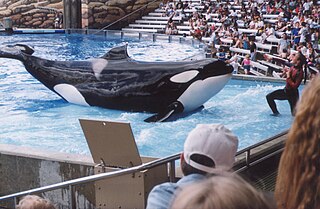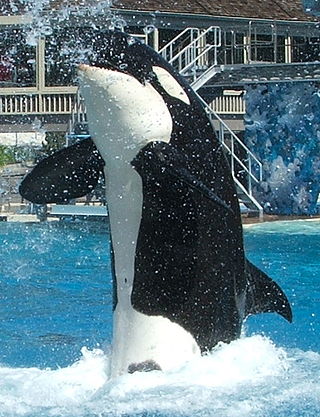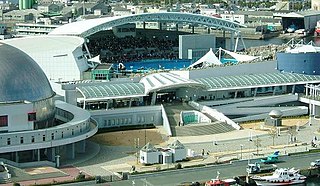Related Research Articles

SeaWorld is an American theme park chain with headquarters in Orlando, Florida. It is a proprietor of marine mammal parks, oceanariums, animal theme parks, and rehabilitation centers owned by SeaWorld Parks & Entertainment. The parks feature orcas, sea lion, and dolphin shows and zoological displays featuring various other marine animals.

The Vancouver Aquarium is a public aquarium located in Stanley Park in Vancouver, British Columbia, Canada. In addition to being a major tourist attraction for Vancouver, the aquarium is a centre for marine research, ocean literacy education, climate activism, conservation and marine animal rehabilitation.
A5 Pod is a name given to a group of orcas found off the coast of British Columbia, Canada. It is part of the northern resident population of orcas - a name given to the fish-eating orcas found in coastal waters ranging from mid-Vancouver Island in British Columbia up through Haida Gwaii and into the southeastern portions of Alaska. The orcas of the Northern Resident community are divided into vocally distinctive clans known as the A clan, the G clan, and the R clan. Members of the A5 Pod belong to the A clan. As of 2013, A5 Pod consisted of 10 members.

Corky II, often referred to as just Corky, is a female captive orca from the A5 Pod of northern resident orcas. At approximately the age of four, Corky was captured from Pender Harbour off the coast of British Columbia on December 11, 1969. She has lived at SeaWorld San Diego in San Diego, California since 1987. As of 2023, she is the oldest and longest kept captive orca.
Shamu was a female orca captured in October 1965 from a southern resident pod. She was sold to SeaWorld San Diego and became a star attraction. Shamu was the fourth orca ever captured, and the second female. She died in August 1971, after about six years of captivity. After her death, the name Shamu continued to be used in SeaWorld "Shamu" shows for different orcas in different SeaWorld parks.

Katina is a female orca who lives in SeaWorld Orlando in Florida. She was captured off Iceland at approximately three years of age on October 26, 1978. She is the most successful breeding female orca in captivity.
Sealand of the Pacific was a public aquarium in South Oak Bay at The Oak Bay Marina, near the city of Victoria, in British Columbia, Canada. It housed a number of orcas: Haida, Nootka, and Tilikum. In 1991, all three were involved in an incident in which a trainer, Keltie Byrne, was killed. The aquarium subsequently closed and sold its orcas to SeaWorld.
Ramu III was an Orca who resided at the now-defunct Windsor Safari Park in Berkshire, England between 1970 and 1976, and later, at SeaWorld San Diego in California between 1976 and 1986. An adult male, Ramu was caught on August 8, 1970, after his pod of eighty orcas was 'corralled' during the Penn Cove capture in Penn Cove, near Coupeville, Washington, United States. At capture, Ramu was 13.32 ft long and a member of the Southern Resident Killer Whales' L-pod. It is assumed his family members still survive in the Salish Sea and in nearby Pacific coastal waters.
Orcas are large, powerful apex predators. There have been multiple killer whale attacks on humans in the wild, but such attacks are less common than those by captive orcas. In captivity, there have been several non-fatal and four fatal attacks on humans since the 1970s. Experts are divided as to whether the injuries and deaths were accidental or deliberate attempts to cause harm.

Springer, officially named A73, is a wild orca from the Northern Resident Community of orcas, which frequents the waters off the northern part of Vancouver Island every summer. In January 2002, Springer, then a calf developmentally equivalent to a human toddler, was discovered alone and emaciated some 250 miles from the territory of her family. Experts identified Springer by her vocal calls that are specific to her family, or "pod," and by examining photographs of her eye patch. They were also able to determine where Springer's pod was currently located.

Dozens of orcas are held in captivity for breeding or performance purposes. The practice of capturing and displaying orcas in exhibitions began in the 1960s, and they soon became popular attractions at public aquariums and aquatic theme parks due to their intelligence, trainability, striking appearance, playfulness, and sheer size. As of June 26, 2023, there were at least 53 orcas in captivity worldwide, 29 of which were captive-born. At that time, there were 18 orcas in the SeaWorld parks.

The southern resident orcas, also known as the southern resident killer whales (SRKW), are the smallest of four communities of the exclusively fish-eating ecotype of orca in the northeast Pacific Ocean. The southern resident orcas form a closed society with no emigration or dispersal of individuals, and no gene flow with other orca populations. The fish-eating ecotype was historically given the name 'resident,' but other ecotypes named 'transient' and 'offshore' are also resident in the same area.
Edward Irving "Ted" Griffin is an American former aquarium owner and entrepreneur who was the first man to ever swim with a killer whale in a public exhibition, with the whale named Namu. He is best known for capturing, performing with, and selling a number of orcas during the late 1960s and early 1970s.

Tilikum, nicknamed Tilly, was a captive male orca who spent most of his life at SeaWorld Orlando in Florida. He was captured in Iceland in 1983; about a year later, he was transferred to Sealand of the Pacific in Victoria, British Columbia. He was subsequently transferred in 1992 to SeaWorld in Orlando, Florida, where he sired 21 calves throughout his life.

Shamu was the stage name used for several captive performing orcas at SeaWorld as part of their theatrical Shamu show beginning in 1960s. The original Shamu died in 1971, but the name was trademarked by SeaWorld, and has been given to different orcas over the years.

Ulises is a male orca who lives at SeaWorld San Diego in California. He was captured off the coast of Iceland in 1980 and is currently the oldest male orca in captivity as of 2022.

The Port of Nagoya Public Aquarium is a public aquarium in Minato-ku, Nagoya, Aichi Prefecture, Japan. It is the public aquarium with the largest tank capacity and total area in Japan. It also owns Japan's largest dolphin show tank.
Tahlequah, also known as J35, is a killer whale of the southern resident community in the northeastern Pacific Ocean. She has given birth to three known offspring, a male (Notch) in 2010, a female (Tali) in 2018, and another male (Phoenix) in 2020. Her second calf, Tali, died shortly after birth and J35 carried her body for 17 days in an apparent show of grief that attracted international attention.
The Yukon Harbor orca capture operation was the first planned, deliberate trapping of a large group of orcas. 15 southern resident orcas were trapped by Ted Griffin and his Seattle Public Aquarium party on 15 February 1967, in Yukon Harbor on the west side of Puget Sound. The first four orcas that had been taken into captivity had been captured singly, and mostly opportunistically. Those four were named Wanda, Moby Doll, Namu, and Shamu—who was then the only surviving one. Through them, interest in orcas had escalated.
References
- ↑ Hoyt, Erich 1990. Orca - The Whale Called Killer. E.P. Dutton, New York
- 1 2 3 4 "Killer Whale Dies While Giving Birth". Orlando Sentinel. Retrieved 2013-05-20.
- ↑ Death at SeaWorld: Shamu and the Dark Side of Killer Whales in Captivity, David Kirby, Page 170
- ↑ Daytona Beach Sunday News-Journal - Mar 15, 1992